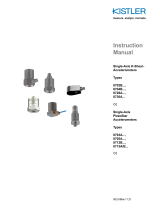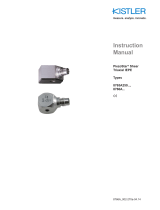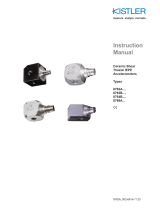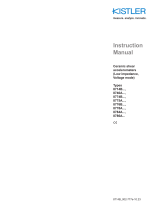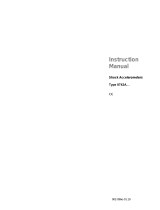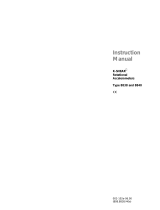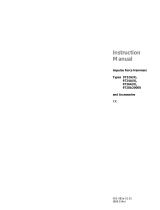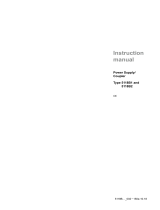Page is loading ...

Instruction
Manual
K-Beam
Accelerometers
Types
8316A...,
8396A...
ä
002-811e-10.21


Foreword
Foreword
002-811e-10.21
Thank you for choosing a Kistler quality product characterized
by technical innovation, precision and long life.
Information in this document is subject to change without notice.
Kistler reserves the right to change or improve its products and
make changes to the content without obligation to notify any
person or organization of such changes or improvements.
© 2015 ... 2021 Kistler Group. All rights reserved. Except as
expressly provided herein, no part of this manual may be repro-
duced for any purpose without the express prior written consent
of Kistler Group.
Kistler Group products are protected by various intellectual
property rights. For more details visit www.kistler.com. The
Kistler Group includes Kistler Holding AG and all its subsidia-
ries in Europe, Asia, the Americas and Australia.
Kistler Group
Eulachstrasse 22
8408 Winterthur
Switzerland
Tel. +41 52 224 11 11
info@kistler.com
www.kistler.com
Page 1

002-811e-10.21Page 2
K-Beam Accelerometers
Content
1. Introduction .......................................................................................................................................4
2. Important information ......................................................................................................................5
2.1 For your safety .......................................................................................................................5
2.2 Precautions ............................................................................................................................5
2.3 Disposal of electronic equipment ...........................................................................................6
2.4 Accelerometers - Types ..........................................................................................................6
3. Product description ..........................................................................................................................8
3.1 Supplied Items........................................................................................................................9
4. Principles of operation.....................................................................................................................9
4.1 Power and output congurations ..........................................................................................11
4.2 Single-ended, unipolar output ..............................................................................................11
4.3 Single-ended, bipolar output ................................................................................................12
4.4 Dierential output .................................................................................................................13
4.5 Cable considerations ............................................................................................................13
5. Installation.......................................................................................................................................14
5.1 Mechanical installation .........................................................................................................14
5.2 Mounting techniques ............................................................................................................15
5.2.1 Stud mounting: Type 8396A....................................................................................16
5.2.2 Screw mounting: Types 8316A... ............................................................................16
5.3 Type 8316AxxxxxACxx .........................................................................................................17
5.3.1 Electrical requirements ...........................................................................................17
5.3.2 Mechanical installation ............................................................................................18
5.4 Types 8316AxxxxxTAxx, 8316AxxxxxTBxx ..........................................................................19
5.4.1 Electrical requirements ...........................................................................................19
5.4.2 Mechanical installation ............................................................................................20
5.5 Type 8396A... general description ........................................................................................23
5.5.1 Electrical requirements ...........................................................................................23
5.5.2 Mechanical requirements .........................................................................................24
6. K-Beam power supply ....................................................................................................................27
6.1 Type 5210 K-Beam power supply ........................................................................................27
6.2 Type 5146A15 15-channel K-Beam power supply ...............................................................28

Page 3002-811e-10.21
Content
Total pages: 38
7. Operation.........................................................................................................................................29
7.1 Noise considerations ............................................................................................................29
7.2 Accessory cables..................................................................................................................29
8. Calibration and maintenance ........................................................................................................31
8.1 General.................................................................................................................................31
8.2 Care and cleaning ................................................................................................................31
8.3 Calibration ............................................................................................................................31
8.3.1 Calibration policy and requirements .......................................................................32
9. Storage and transit considerations ..............................................................................................33
10. Warranty ........................................................................................................................................34
11. Declaration of conformity ............................................................................................................35
12. Appendix .......................................................................................................................................37
A Measuring chains .................................................................................................................37

002-811e-10.21
K-Beam Accelerometers
Page 4
Thank you for choosing a quality product from Kistler. Please
read through this manual thoroughly to enable you to fully
exploit the various features of your product.
To the extent permitted by law Kistler accepts no liability if
this instruction manual is not followed or products other than
those listed under Accessories are used.
Performance features at a glance:
Small, lightweight variable capacitance sensing element
Integral cable and connector options
Bipolar, single-ended or dierential outputs
High sensitivity
From True DC to high frequency response
Seismic ground insulation
Mounting options
Conforming to CE
Kistler oers a wide range of products for use in measuring
technology:
Piezoelectric sensors for measuring force, torque, strain,
pressure, acceleration, shock, vibration and acoustic
emission
Strain gage sensor systems for measuring force and
torque
Piezoresistive pressure sensors and transmitters
Signal conditioners, indicators and calibrators
Electronic control and monitoring systems, as well as
software for specic measurement applications
Data transmission modules (telemetry)
Kistler also develops and produces measuring solutions
for the application elds engines, vehicles, manufacturing,
plastics and biomechanics sectors.
Our product and application brochures, in addition to our
detailed data sheets, will provide you with an overview of our
product range. All unit measurements provided are listed in
order of meters, followed by inches [in brackets].
If you require additional help beyond what can be located
online or in this manual, please contact Kistler‘s extensive
support organization or visit us online at www.kistler.com.
1. Introduction

002-811e-10.21
Important Information
Page 5
2. Important information
This product has been manufactured in compliance with
current valid safety regulations. It has left the factory in a
perfect, safe condition. In order to maintain this condition
and ensure safe operation, compliance is required with the
instructions and warning notes contained within this manual
or imprinted on the product itself.
Compliance with local safety regulations, which may apply
to the use of power line operated electrical and electronic
equipment, is strongly recommended.
It is essential for you to review the following information,
which is intended to ensure your personal safety when
working with the K-Beam Accelerometers and contribute
toward a long-fault-free service life.
2.1 For your safety
2.2 Precautions
Compliance with the following precautionary measures is
vital to ensure safe and reliable operation.
▪ Never expose the instrument to contamination or oil mist.
▪ Never operate or store the instrument outside the specified
temperature range.
▪ Never exceed the maximum stated voltage.
▪ Connect the instrument only to equipment for which it was
designed to be used.
▪ Never allow the product to drop.
▪ The environment should be as dry, clean and free from vi-
brations as possible.
▪ Never operate the instrument if there are visible signs of-
damage.
▪ Follow the instructions for mounting.
▪ Do not expose the unit to excessive shock, i.e. by using a
hammer or dropping the unit.
▪ Store the accelerometer in the container supplied. Always
store in a clean, dry area.
▪ Keep connectors clean and covered when not in use.

002-811e-10.21
K-Beam Accelerometers
Page 6
If there is evidence that safe operation is no longer possible,
the instrument must be powered o and rendered safe
against accidental start-up. Safe operation is no longer
possible when the product:
shows visible signs of damage
is no longer operating
has been subjected to prolonged storage under unsuitable
conditions
has been subjected to rough transit conditions
2.3 Disposal of electronic equipment
Do not discard old electronic equipment in municipal trash.
For disposal at end of life, please return this product to the
nearest authorized electronic waste disposal service or
contact your Kistler sales oce for disposal instructions.
2.4 Accelerometers - Types
This instruction manual summarizes the Kistler K-Beam
Accelerometer product line, which includes the Type 8316A…
and Type 8396A… series of K-Beam accelerometers.

002-811e-10.21
Important Information
Page 7
Type 8396A...
Fig. 1: K-Beam product line
Type 8316A...AC
Type 8316A...TA
Type 8316A...TB

002-811e-10.21
K-Beam Accelerometers
Page 8
3. Product description
All K-Beam accelerometers have integrated signal conditio-
ning electronics.
Types 8316A…TA and 8316A…TB feature a welded tita-
nium housing with either an industry standard 4 pin, ¼–28
connector (TA) or integral PTFE jacketed cable (TB). The
maximum temperature range is +125 °C (+260 °F) and
the available output signal formats are bipolar 0±4 V (with
temperature output), single-ended 2.5±2 V (with tempera-
ture output) and dierential 0±4 V or 0±8 V. Temperature
output is provided if external compensation of the output
signal is desired. The sensing element and electronics are
contained in the lightweight, welded titanium housing for a
fully hermetic design with integral ground isolation.
Type 8316A…AC features a hard, anodized aluminum
housing with an epoxy seal and an integral PVC cab-
le. The maximum temperature range is +85 °C (+185
°F) and the available output signal formats are bipolar
0±4 V, single-ended 2.5±2 V and dierential 0±4 V or
0±8 V. The sensing element and electronics are contained
in this lightweight housing with an environmental seal and
integral ground isolation.
Type 8396A… is a triaxial accelerometer that measures
acceleration in three orthogonal axes simultaneously. The
output signal format is available as bipolar 0±4 V, sing-
le-ended 2.5 V±2 V and 0±4 V or 0±8 V dierential. Tem-
perature output is provided if external compensation of the
output signal is desired. The sensing element and electro-
nics are contained in lightweight, welded titanium housing
with either a circular 9 pin connector or an integral cable
with braid shield protection terminated by pigtails or 9 pin
D-Sub connector.

002-811e-10.21
Principles of Operation
Page 9
3.1 Supplied Items
Items supplied with the accelerometer are listed on the
product data sheet or contained within Section 8 of this
manual.
4. Principles of operation
Most Kistler K-Beam accelerometer sensing elements consist
of a very small inertial mass and exure elements chemically
etched from a single piece of silicon. The seismic mass is
supported by exure elements between two plates, which act
as electrodes. As the mass deects under acceleration, the
capacitance between these plates changes. Under very large
accelerations (or shocks), the motion of the mass is limited
by the two stationary plates; this limits the stress placed on
the suspension and prevents damage. The damping of the
mass by an entrapped gas creates a "squeeze lm" providing
an optimized frequency response over a wide temperature
range. Additionally, its dierential capacitive design assures
immunity from thermal transients.
Signal conditioning for K-Beam accelerometers (see Fig. 2)
incorporates AC excitation and synchronous demodulation.
The signal conditioner provides the power conditioning for
the accelerometer element and outputs an analog voltage
proportional to the acceleration signal.
Fig. 2: Diagram of a typical K-Beam accelerometer
measuring chain

002-811e-10.21
K-Beam Accelerometers
Page 10
All K-Beam accelerometers provide an output signal similar
to that produced by a piezoelectric accelerometer. Unlike a
piezoelectric accelerometer, K-Beams are sensitive to static
acceleration. Therefore, earth's gravity is a factor in the out-
put signal and must be taken into account when mounting.
As described earlier, K-Beam accelerometers produce an
output when forces acting on a moveable element cause the
element to change position. When the sensor is parallel to
the ground, (see Fig. 3) the earth's gravity will produce an
output equivalent to 1 g. When the device is rotated 90°, ma-
king the sensing element perpendicular to earth's gravitati-
onal pull, a static output equivalent to 0 g is produced (see
Technical Data table). As the sensor is rotated between 0°
and 90°, the static acceleration output signal amplitude will
vary by approximately the sine of.
±1 g 0 g -1 g
Fig. 3: A Mounted K-Beam and the respective outputs
relative to the earth's orientation

002-811e-10.21
Principles of Operation
Page 11
4.1 Power and output congurations
Most K-Beam accelerometers are available with various
power and output congurations, which are described in
Sections 4.1.1 - 4.1.3 and in Table 1.
Type Single-
ended,
unipolar
Single-
ended,
bipolar
Dierential Tempera-
ture output
Power
supply
require-
ments
(VDC)
8316AxxxxxTAxx ▪ ▪ ▪ ▪ 6 – 50
8316AxxxxxTBxx ▪ ▪ ▪ ▪ 6 – 50
8316AxxxxxACxx ▪6 – 50
8396AxxxxxTxxx ▪ ▪ ▪ ▪ 6 – 50
Table 1: Available K-Beam output configurations
*Maximum supply voltage limited above 210 °F (see
Technical data)
To avoid confusion when identifying and correlating male
(pos.) pin connections on the sensor connector and female
(neg.) connector pins on a cable end, only the connector end
view of the accelerometer will be shown further.
4.2 Single-ended, unipolar output
The single-ended, unipolar output conguration is a single
output referenced to the signal/power supply ground (see Fig.
4). This conguration provides a +2.5 VDC output at zero g
input. Full-scale output voltage is dependent upon the sensor
model. The output voltage never goes below zero volts in this
conguration. Types 8316AxxxB0xxxx, 8316AxxxBTxxxx,
and 8396AxxxBTTxxx operate from a power supply with sing-
le-ended, unipolar outputs.

002-811e-10.21
K-Beam Accelerometers
Page 12
Fig. 4: Single-ended, unipolar and bipolar Type 8316A...
and Type 8396A… congurations with the signal
and power supply referenced to ground. See prod-
uct data sheets for applicable pin designations.
4.3 Single-ended, bipolar output
This option provides a zero voltage output at zero g
input. The output signal is bipolar (+/-) corresponding to posi-
tive and negative acceleration.
Types 8316AxxxA0xxxx, 8316AxxxATxxxx, and
8396AxxxATTxxx will operate under the same conguration
as Fig. 4.

002-811e-10.21
Principles of Operation
Page 13
4.4 Dierential output
Units supplied with this option are designed for operation
from a single polarity power supply. This option provides
a dierential output (see Fig. 5) where the output signal is
provided on two wires. A higher eective sensitivity (X2) and
zero volts at zero g input are among the characteristics of this
option. Another important benet of this conguration is the
rejection of common mode noise, especially important when
driving long cable lengths.
For proper operation, the data acquisition system or readout
instrumentation must have a dierential input.
Types 8316AxxxC0xxxx, 8316AxxxD0xxxx, 8396AxxxC-
TTxxx, and 8396AxxxDTTxxx are providing a dierential
output.
Fig. 5: Type 8316A... and Type 8396A... dierential output
congurations. See individual product data sheets
for applicable pin designations.
4.5 Cable considerations
It is important to observe the maximum cable lengths and
maximum cable capacitance specied in the product data
sheet. It may be permissible to exceed the specied cable
length provided the following guidelines are observed:
When using long cables, the power supply voltage may
need to be increased to compensate for the voltage drop
caused by wire resistance.
Use low capacitance cables and ensure that the maximum
specied capacitance is not exceeded.
Oset voltage can increase as cable length is increased
due to wire resistance causing a power supply ground
shift at the accelerometer.

002-811e-10.21
K-Beam Accelerometers
Page 14
5. Installation
This section is divided into three sub-sections:
Mechanical installation
Mounting techniques
Mechanical and electrical requirements (by Type)
K-Beam accelerometers with special mounting requirements
are further described in their appropriate sections. It should
be noted that the output signal from K-Beam accelerometers
is compatible with most measuring instruments and further
signal conditioning is unnecessary.
Always observe the maximum capacitive load and the
minimum resistive load specied on the product data sheets.
5.1 Mechanical installation
Proper mounting plays an important role in making accura-
te acceleration measurements. This section will provide the
user with some general guidelines:
The accelerometer must be rigidly coupled to the structure
being monitored if it is to track the movement of the struc-
ture with good delity. In general, using epoxy or the unit’s
mounting holes provides sucient coupling between the
sensor and the mounting surface.
The user should take the necessary measures to ensure
that the mounting surface or xture does not have a reso-
nant frequency within the measurement frequency range.
A xture resonance can cause a high amplitude respon-
se that is not representative of the test article. Damping
techniques can often solve this problem or by selecting
a more stable mounting surface. It is recommended that
the accelerometer be tested at a variety of frequencies in
order to identify any undesired resonant conditions.
Contact your sales representative or Kistler directly for
specic application information.

002-811e-10.21
Installation
Page 15
5.2 Mounting techniques
K-Beam accelerometers are ideally suited for adhesive
mounting due to the low mass and available mounting area.
Due to K-Beam's nature of measuring relatively modest acce-
lerations at low frequencies, most applications will require a
minimal uniform application of Petro Wax for sucient moun-
ting attachment.
The Petro Wax recommended is Kistler Type 8432 (Katt &
Associates Type P102, P.O. Box 623, Zoar, Ohio 44697 USA)
or an equivalent. Wax can be used if it provides repeatable
results after the unit has been removed and remounted.
A minimal, uniform layer (0.10 mm [<0.004 in]) should be
applied to the test structure's surface. The accelerometer is
then applied to this wax layer with rm nger pressure and an
alternating twisting motion.
The Type 8432 wax is intended for laboratory type applica-
tions where ambient temperatures are near 20 °C (70 °F). A
wax which is more pliable at 20 °C (70 °F) is recommended
for low temperature applications (Katt & Associates Type
P103). Specially formulated high temperature wax is also
available (Katt & Associates Type P104).
Input excitations of 20g RMS or greater may dictate the use
of a stronger attachment medium. A cyanoacrylate adhe-
sive should be used in these cases (Permabond 910 Adhe-
sive from: Permabond International, 480 South Dean Street,
Englewood, NJ 07631, USA or equivalent). A two component
structural adhesive can be used for permanent attachment
but is NOT recommended for temporary installations.
Removal of an adhesively mounted accelerometer is accom-
plished by applying the adhesive manufacturer's recom-
mended adhesive solvent and allowing the solvent to
soften the adhesive. Acetone is eective for the removal of
cyanoacrylate adhesives. Use the proper size wrench to twist
the sensor loose and break-o the adhesive.
DO NOT IMPACT ACCELEROMETER!
Refer to Section 8.2 for adhesive removal and cleaning
procedures.

002-811e-10.21
K-Beam Accelerometers
Page 16
1. Drill and tap an adequate hole to ensure a ush mount of
the accelerometer. Make sure the stud does not bottom
out, either in the mounting hole of the test structure or in
the accelerometer base. A chamfer should be machined at
the top of the mounting hole to ensure that the base of the
accelerometer makes full contact with the mounting surfa-
ce.
2. Completely clean the surface prior to mounting.
3. Apply a thin coat of silicon grease to both the accelerome-
ter and mounting surface.
4. Always use the proper sockets and a torque wrench
when installing accelerometers. For Type 8396A…, tigh-
ten the accelerometer to a torque of 0.85 ±0.06 N•m
[7.5 ±0.5 in-lbs].
5.2.2 Screw mounting: Types 8316A...
Mounting holes in the accelerometer housing are provided
for mounting screws or other fasteners. The product data
sheet describes the applicable mounting screws. Appropriate
mounting screws are supplied. When preparing mounting
holes in the structure, they should be perpendicular to the
attaching surface and free from all burrs. The sensor's moun-
ting surface must be in uniform contact with the test structure.
Never use fasteners larger than those described on the data
sheet. Fasteners must not restrict the unit by contacting the
walls of the unit's holes. The recommended mounting torque
is 0.7 N•m [6 lbf-in].
In some cases, mounting screws are used with insulating
components such as washers. These insulating components
are necessary for protecting or assuring electrical isolation.
5.2.1 Stud mounting: Type 8396A...
Type 8396A… has a KIAG 10-32 threaded hole for stud
mounting. Most Kistler mounting studs are machined from
Beryllium Copper for high strength and low modulus of elasti-
city, coupled with high elastic limits. The stud is removable
allowing both stud and adhesive mounting. The following
guidelines should be followed when stud mounting accelero-
meters.

002-811e-10.21
Installation
Page 17
This sensor requires either a regulated power supply or can
operate from a 9-Volt battery. When using a regulated power
supply, the sensor will operate over a voltage range of 6 ... 50
Volts (at temperature ≤100 °C [210 °F]) and the supply should
be capable of furnishing 4 mA of current. The power supply
regulation must be within ±0.1 % and the noise and ripple
cannot exceed 1.5 mV RMS.
The sensor case and substrate are electrically isolated from
ground. The cable shield is oating at the sensor end of the
cable.
For Type 8316AxxxxxTBxx, power and signal connections
are made directly to the integral cable. Pigtail wire assign-
ment is shown in Table 2 below. Both are ground isolated.
Fig. 6: Type 8316AxxxxxACxx dimensions (in [mm])
5.3 Type 8316AxxxxxACxx
Type 8316AxxxxxACxxx… is supplied in four electrical output
versions as described in Section 3. The reader should refer
to sensor datasheet if there are any questions regarding the
identication of the unit's ordering key.
5.3.1 Electrical requirements

002-811e-10.21
K-Beam Accelerometers
Page 18
Type 8316AxxxxxACxx comes with a hard coat anodized
aluminum outer housing to protect the sensing package and
the cable connections. The housing contains two holes of
3.2 mm [0.125 in] to accept mounting screws.
Mounting screws and ber washers are furnished. Two each
of M3 x 12 mm socket and 4-40 x ½" socket head cap screw
with 4 washers are supplied accessories. The washers are
made of an insulating ber material and should be used to
insure that electrical isolation is maintained.
For temporary installations, the accelerometer can be
mounted using Petro Wax. See Section 5.2.1 for more infor-
mation on this product. For permanent installations, the unit
can be mounted using epoxy.
5.3.2 Mechanical installation
Once the sensor is mounted with epoxy, it cannot be re-
moved without risking damage.
The sensitive axis is perpendicular to the mounting surface.
Refer to Section 5.2 for general information about proper
mounting.
For applications requiring measurements in more than a
single axis, a convenient optional accessory is available.
The Type 8522 triaxial mounting cube provides a mounting
method for up to three Type 8316A… accelerometers posi-
tioned in three orthogonal axes. Where mass and space
permits, this mounting cube oers an economical approach
to multi-axis measuring.
Electrical Interface Type 8316A... Function Output
Wire Color Type A0, B0 Type C0, D0
red power power
black return return
yellow temp. output + output -
white output + output +
shield case case
Table 2: Pigtail interface connections
/
